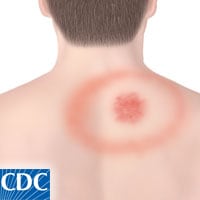(check this post out on our new site, Infectious News)
Every so often, a disease becomes shrouded in rumor and innuendo until it is difficult to parse out truth from fiction. People can take “pro” and “anti” stances, and the topic becomes unnecessarily charged. Anyone suffering from that disease can become either an involuntary “champion” or the subject of intense eye-rolling. This is clearly the case with Lyme disease, or more specifically, an ailment called “post-treatment Lyme syndrome” (NOTE: this is distinctly different from the widely circulated name “chronic Lyme disease”, which is a hotly contested and widely debated concept).
Every so often, a disease becomes shrouded in rumor and innuendo until it is difficult to parse out truth from fiction. People can take “pro” and “anti” stances, and the topic becomes unnecessarily charged. Anyone suffering from that disease can become either an involuntary “champion” or the subject of intense eye-rolling. This is clearly the case with Lyme disease, or more specifically, an ailment called “post-treatment Lyme syndrome” (NOTE: this is distinctly different from the widely circulated name “chronic Lyme disease”, which is a hotly contested and widely debated concept).
Most people who
become infected with Borrelia burgdorferi
following a bit from an infected tick will develop classic symptoms of Lyme
disease including a high fever, malaise, headache, painful joints, and in somewhere
between 60-80% of cases, a very distinctive rash. This rash is called erythema migrans, but is
more commonly known as a “bull's eye rash” for obvious reasons (see images below)! The rash is where a lot of the trouble comes
from. Most of us in the Northeast know
that a fever and a bull's eye rash means that one must get to the doctor for Lyme
treatment immediately. Patients presenting
this way are usually prescribed the appropriate antibiotic (doxycycline as a
standard) in a timely manner and almost always recover fully. Those
patients who are the 20-40% without the bullseye rash can run into trouble
getting a timely diagnosis and the appropriate treatment. This
is a problem.
B. burgdorferi
initially replicates very happily around the site of the tick bite, and then
eventually makes its way to the joints. Occasionally
it finds its way into the heart. Eventually
the bacteria invade the spinal cord and brain if left untreated. One could see where a timely diagnosis and treatment
would be critical, given that inflammation and damage done to joints, heart
muscle, and especially brain does not readily heal. Even if the bacteria are eliminated by
antibiotic therapy, the damage they generated tends to leave lasting
consequences. These can include joint
degeneration, arrhythmias and other cardiac complications, cognitive impairment,
hearing or vision loss, loss of motor coordination, possible psychiatric
effects, and above all, chronic pain.
Such ailments are life-altering, and should be taken as such.
The internet is likely both the best and worst thing that
could have happened for post-treatment Lyme syndrome. Patients suffering from chronic illness often
benefit from connecting with others in similar situations. On the other hand, there is space for
ambiguity in this case because some of its clinical presentations are not
visible and the mechanisms underlying the disease are still being discovered as
we speak. Ambiguity and the uncensored internet
are not necessarily a good combination, and are breeding grounds for zealots and charlatans (such as these from the "FDA" at FDA.com, not to be confused with the actual FDA at FDA.gov).
All manner of problems have become connected to “chronic Lyme disease”, often
with a complete and total lack of peer-reviewed evidence, such as this and this. This leads some to conclude that anyone with
post-Lyme complications is a malingerer, a drug seeker, a conspiracy theorist, or in need of a mental
health evaluation. As described above, this is not the case. That said, every claim made on the internet
cannot and should not be counted as fact.
In preparing this short piece I have spent quite a bit of time reading
the most recent peer-reviewed research, and was left feeling a bit overwhelmed
by the nuance of this disease. It is
extremely complex, and the design of each study coupled with its statistical methods
therefore become critical in evaluating the conclusions. I definitely feel that an hourly “Lymeology”
series is in order to tease some of these nuances apart. Sufficed to say that there is quite a bit of
complexity and much more work still needed to be done and published, and in
those situations, rumor and innuendo can take over. When they do, the entire topic becomes
nuclear and polarizing. Those who
suffer? The 10% of patients left with lasting
complications whose treatment is often a clinician’s best guess rather than an
established standard of care.
In closing, it’s just about tick season, and it is predictedto be a bad one. If you want to avoid a first-hand experience with this topic, it’s best to prevent infection in the first place. Here’s how.
Perspective of tick size, for your nightly checks (image: dhs.wisconsin.gov)






No comments:
Post a Comment